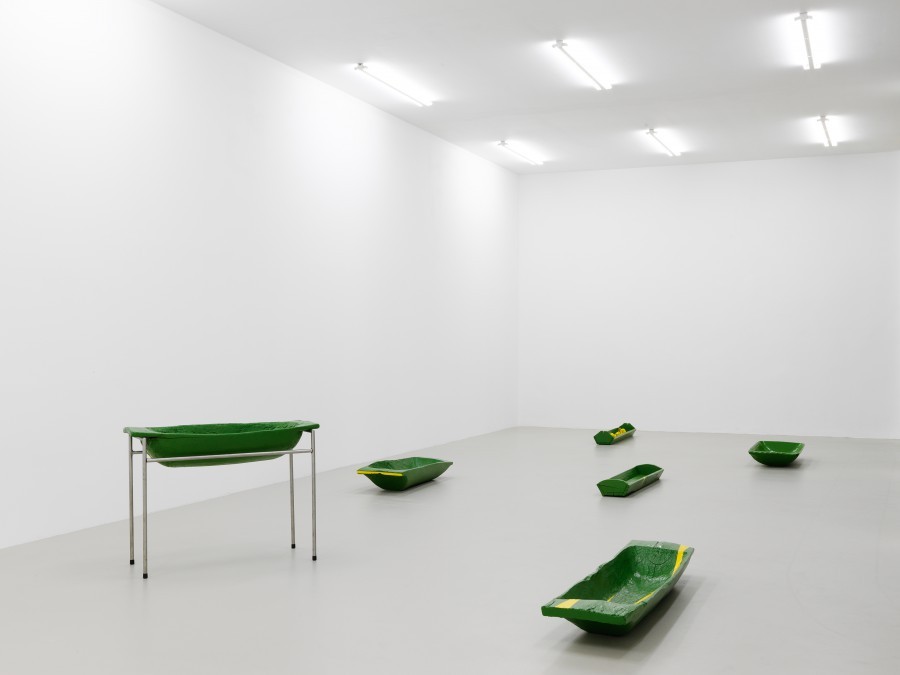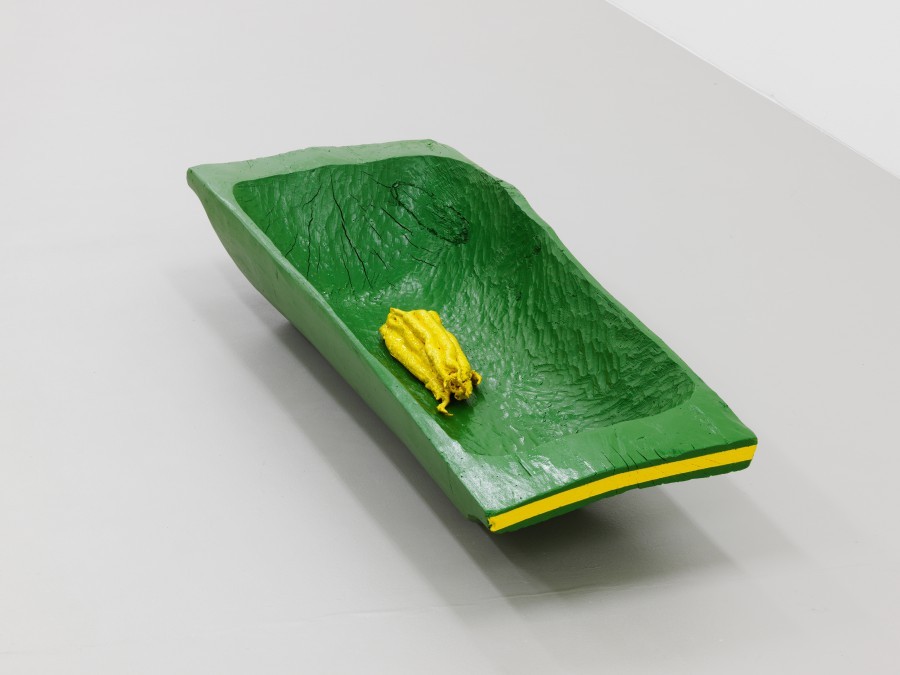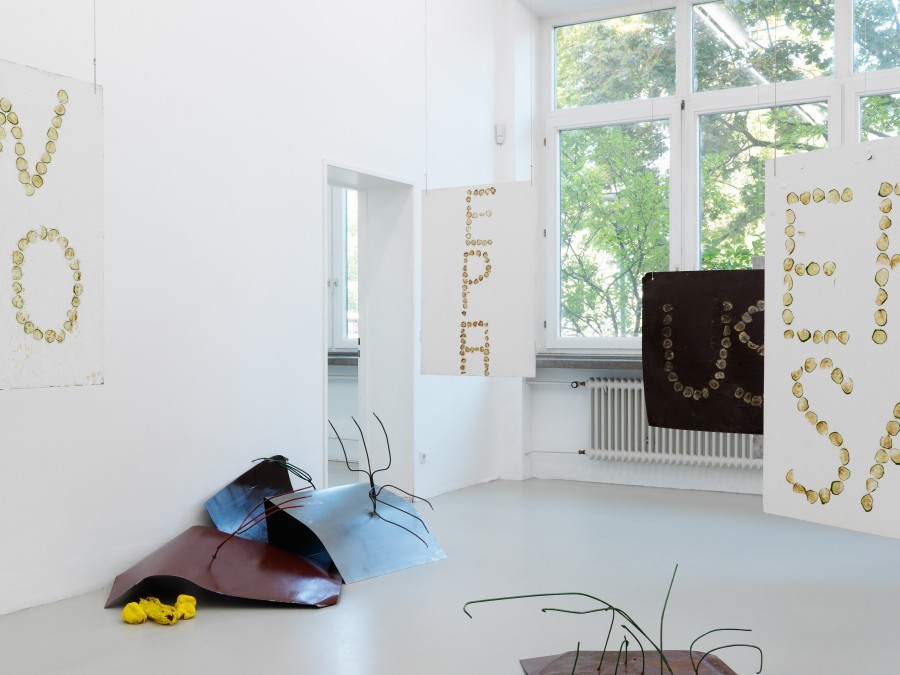Olga Balema
One reenters the garden by becoming a vegetable
12 Sep - 08 Nov 2015

Olga Balema
One reenters the garden by becoming a vegetable, 2015
Installation view, Kunstverein Nürnberg
Photo: Annette Kradisch
One reenters the garden by becoming a vegetable, 2015
Installation view, Kunstverein Nürnberg
Photo: Annette Kradisch

Olga Balema
Wild possession, 2015
feeding trough, paint
36 x 154 x 18 cm
Kunstverein Nürnberg, 2015. Photo: Annette Kradisch
Wild possession, 2015
feeding trough, paint
36 x 154 x 18 cm
Kunstverein Nürnberg, 2015. Photo: Annette Kradisch

Olga Balema
Analysis penetrates the surface, 2015
feeding trough, paint, latex
37 x 120 x 20 cm
Kunstverein Nürnberg, 2015. Photo: Annette Kradisch
Analysis penetrates the surface, 2015
feeding trough, paint, latex
37 x 120 x 20 cm
Kunstverein Nürnberg, 2015. Photo: Annette Kradisch

Olga Balema
One reenters the garden by becoming a vegetable
Installation view, Kunstverein Nürnberg, 2015. Photo: Annette Kradisch
One reenters the garden by becoming a vegetable
Installation view, Kunstverein Nürnberg, 2015. Photo: Annette Kradisch
OLGA BALEMA
One reenters the garden by becoming a vegetable
12 September - 8 November 2015
Kunstverein Nürnberg - Albrecht Dürer Gesellschaft is pleased to present the first institutional solo exhibition by Olga Balema (*1984, Ukraine) in Germany.
With a series of new works at the Kunstverein, Olga Balema turns her attention to the cultivation of food. Agriculture as an institution has shaped many cultural beliefs that determine our relationship to our environment and to other living creatures up to today. Even in its most ancient state the production of food through farming has aggression as its basis, which becomes expressed in territorial land seizure, in the hierarchies between social classes, gender inequality, as well as in the treatment of animals and plants. Balema addresses this violent aspect of agriculture in her sculptures, as well as the look at the “other”, the “alien”, that is always contained in our observation of nature.
With her exhibition title “One reenters the garden by becoming a vegetable”, the artist makes reference to the book “From Communion to Cannibalism” (1990) by Maggie Kilgour. In her book, the scholar of English literature investigates metaphors of incorporation in western cultural history, literature and religion. The opposition between inside and outside, between eater and eaten, is not reciprocal, but culminates in a process of ingestion that ultimately transforms our identity.
Balema scrutinizes this relation in her works by reflecting on the production of food, and with it, the human processing of nature. Her sculptures in the large gallery space of the Kunstverein, such as “Natural submission”, “Latest scientific research” and “Full of pests”, present a series of found feeding troughs, which in their form and fabrication recall traditional and modern keeping of livestock. Such troughs are also frequently used as decorative objects in gardens, restaurants and domestic spaces. As cultural artefacts, the objects activate different notions and nostalgic images of farming. Thereby, the aggressive thick green paint and yellow signal stripes locate the objects in the rational, industrial zone of agriculture, with tractors, harvesters and reapers.
With her metal sculptures “Regulatory bodies” and “Weeds I – IV” Balema focuses further on the invasive actions of agriculture. Enduring, stable materials such as metal are combined with organic matter, such as saltpickled cucumber slices. Surfaces are marked by tactile traces, corrosion and oxidation that imitate decay and nature’s repossession by means of physical processes. The lettering on the metal objects refers to governmental agencies that include the “United States Department of Agriculture” (USDA), the “Environmental Protection Agency” (EPA), the “European Food Safety Authority”, the “Food and Agriculture Organization of the United Nations” (FAO), and the “German Federal Ministry of Food, Agriculture and Consumer Protection” (Bundesministerium für Ernährung, Landwirtschaft und Verbraucherschutz, BMELV). All of them present themselves on their websites as leaders in the conservation and renewal of water, soil and land.
In her works, Balema traces the ambivalent relationship of human beings with their environment: With sculptural fragments and gestures, she reflects on the ongoing double bind that we confront in the production of food and our eating habits themselves
Olga Balema (b. 1984, Lviv, Ukraine) lives and works in Amsterdam. From 2002 to 2009 she studied Sculpture at the University of Iowa, USA and New Genres at the University of California, Los Angeles. From 2011 to 2012 she had a residency at the Rijksakademie van beeldende kunsten, Amsterdam. In the last years she presented her works in international solo exhibitions as for example at the Gallery Croy Nielsen, Berlin and Gallery Michael Thibault, Los Angeles (with Anne de Vries) (2015); at the Kunstvereiniging Diepenheim, Netherlands (with Jonathan Baldock) (2014) as well as at the project space 1646, Den Haag (2013). Besides, she was represented in numerous group exhibitions as in Surround Audience, Triennial, New Museum, New York (2015); in Nature after Nature, Fridericianum, Kassel; in Doom: Surface Control, Le Magasin Grenoble – CNAC, Grenoble; in Puddle, pothole, portal, Sculpture Center, New York as well as in Geographies of Contamination, David Roberts Art Foundation, London (all 2014).
One reenters the garden by becoming a vegetable
12 September - 8 November 2015
Kunstverein Nürnberg - Albrecht Dürer Gesellschaft is pleased to present the first institutional solo exhibition by Olga Balema (*1984, Ukraine) in Germany.
With a series of new works at the Kunstverein, Olga Balema turns her attention to the cultivation of food. Agriculture as an institution has shaped many cultural beliefs that determine our relationship to our environment and to other living creatures up to today. Even in its most ancient state the production of food through farming has aggression as its basis, which becomes expressed in territorial land seizure, in the hierarchies between social classes, gender inequality, as well as in the treatment of animals and plants. Balema addresses this violent aspect of agriculture in her sculptures, as well as the look at the “other”, the “alien”, that is always contained in our observation of nature.
With her exhibition title “One reenters the garden by becoming a vegetable”, the artist makes reference to the book “From Communion to Cannibalism” (1990) by Maggie Kilgour. In her book, the scholar of English literature investigates metaphors of incorporation in western cultural history, literature and religion. The opposition between inside and outside, between eater and eaten, is not reciprocal, but culminates in a process of ingestion that ultimately transforms our identity.
Balema scrutinizes this relation in her works by reflecting on the production of food, and with it, the human processing of nature. Her sculptures in the large gallery space of the Kunstverein, such as “Natural submission”, “Latest scientific research” and “Full of pests”, present a series of found feeding troughs, which in their form and fabrication recall traditional and modern keeping of livestock. Such troughs are also frequently used as decorative objects in gardens, restaurants and domestic spaces. As cultural artefacts, the objects activate different notions and nostalgic images of farming. Thereby, the aggressive thick green paint and yellow signal stripes locate the objects in the rational, industrial zone of agriculture, with tractors, harvesters and reapers.
With her metal sculptures “Regulatory bodies” and “Weeds I – IV” Balema focuses further on the invasive actions of agriculture. Enduring, stable materials such as metal are combined with organic matter, such as saltpickled cucumber slices. Surfaces are marked by tactile traces, corrosion and oxidation that imitate decay and nature’s repossession by means of physical processes. The lettering on the metal objects refers to governmental agencies that include the “United States Department of Agriculture” (USDA), the “Environmental Protection Agency” (EPA), the “European Food Safety Authority”, the “Food and Agriculture Organization of the United Nations” (FAO), and the “German Federal Ministry of Food, Agriculture and Consumer Protection” (Bundesministerium für Ernährung, Landwirtschaft und Verbraucherschutz, BMELV). All of them present themselves on their websites as leaders in the conservation and renewal of water, soil and land.
In her works, Balema traces the ambivalent relationship of human beings with their environment: With sculptural fragments and gestures, she reflects on the ongoing double bind that we confront in the production of food and our eating habits themselves
Olga Balema (b. 1984, Lviv, Ukraine) lives and works in Amsterdam. From 2002 to 2009 she studied Sculpture at the University of Iowa, USA and New Genres at the University of California, Los Angeles. From 2011 to 2012 she had a residency at the Rijksakademie van beeldende kunsten, Amsterdam. In the last years she presented her works in international solo exhibitions as for example at the Gallery Croy Nielsen, Berlin and Gallery Michael Thibault, Los Angeles (with Anne de Vries) (2015); at the Kunstvereiniging Diepenheim, Netherlands (with Jonathan Baldock) (2014) as well as at the project space 1646, Den Haag (2013). Besides, she was represented in numerous group exhibitions as in Surround Audience, Triennial, New Museum, New York (2015); in Nature after Nature, Fridericianum, Kassel; in Doom: Surface Control, Le Magasin Grenoble – CNAC, Grenoble; in Puddle, pothole, portal, Sculpture Center, New York as well as in Geographies of Contamination, David Roberts Art Foundation, London (all 2014).
